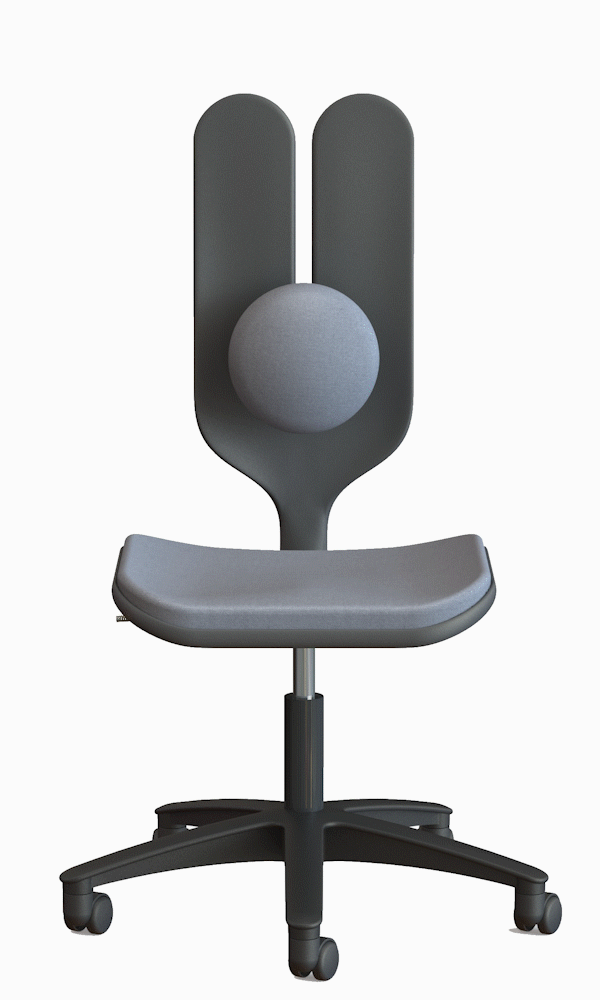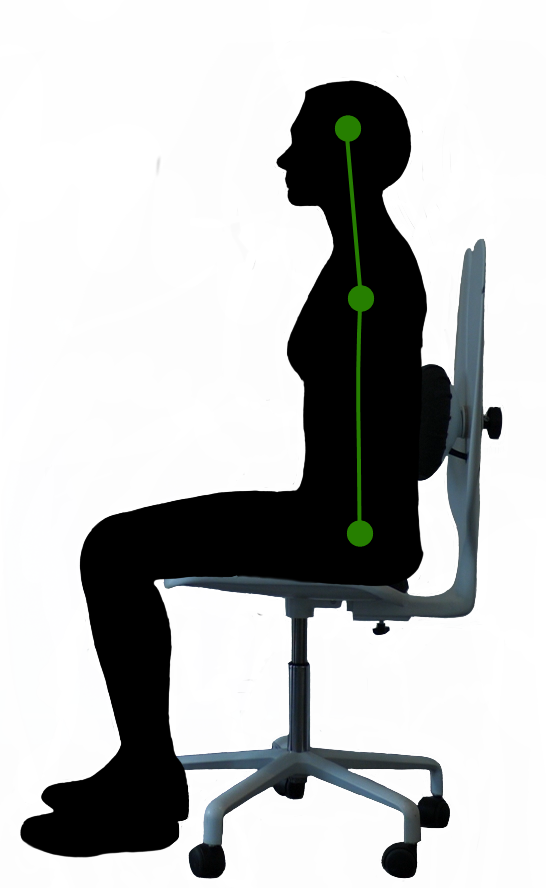set up
faqs
Overarched back:
Do not try to forcefully sit back into the chair. If you try to arch your back as you “sit back”, then your lower back muscles will still be working and you may be gripping through your hips and tipping your pelvis forwards. Try to relax your muscles and allow your body weight to fall backwards from your hips, letting the ephgrave chair do the work for you.
Tucking feet under chair:
It is important to let your feet rest on the floor. Tucking your feet back under the chair increases the tension in your quads muscle. This pulls your body weight forward, unbalancing your spine, and causing you to grip with your hips and lower back. Letting your feet rest flat on the floor allows your body weight to move backwards so the pelvis and lower back can relax and let the chair do its work.
Positioning of cushion:
– Too low:
If you position the cushion too low (beneath the keystone vertebra), then the cushion will exaggerate the arch of the lower back and the spine will collapse above it (as in a conventional office chair). Your mid-back will slump and your head and shoulders will fall forward.
– Too high:
If you position the cushion too high (above the keystone vertebra) then it will push the upper body too far forwards and the lower back will collapse down beneath it. It will feel like the chair is pushing you forwards and downwards, encouraging your spine to collapse into a C-shape.
– The impact of changing your sitting position:
The back cushion may initially feel very different to what you are used to. Muscles and joints will be positioned differently and need time to adapt. It can take up to 3 weeks for your body to adjust to your new chair but any initial discomfort will wear off as your posture improves. If you have any questions or concerns, please do contact us for help and advice.
Arm rests prevent the user from bringing the chair in close enough to the desk to utilise the back support. The user “perches” forwards on the seat to reach the keyboard and is effectively sitting unsupported. With no arms rests to collide with the desk, the ephgrave chair can easily be pulled close to the desk, facilitating use of the back support.
When the seat is too deep, it is often difficult and unwieldy to pull the chair in close enough to the desk. Users therefore position the chair too far back and either “perch” forward on the seat without using the back support, or else bring their bottom forward and then lean back into a slump position as they tire. With a shorter seat, it is easy to pull the ephgrave chair in close enough to the desk to ensure the back support is used.
With a standing desk your spine has no passive support. The brain/body has to work harder to actively keep itself upright and balanced over the feet. Over time, you will shift position and sink down into certain joints as the muscles get fatigued. The ephgrave chair effortlessly keeps the spine aligned, reducing fatigue and freeing your mind to concentrate on the task at hand.
This is because our bodies adapt to the position they are most often in. If you habitually use a chair that allows your upper body to slump, then the muscles around the joints adapt to that position so it feels “normal” and quite comfortable for a short period of time. However, as the joints are poorly aligned, over a period of time they become slowly overloaded and painful – hence the feeling of growing discomfort over the day.
A gym ball gives you an unstable base to sit on with no support for your spine. This is useful in a gym session when you are focussing on training your muscles to support your body correctly. When carrying out desk-based activities, your mind is focussed on these tasks, not on your body. It takes a lot of effort to hold the moveable parts centrally balanced on an unstable base. Your muscles will fatigue and the short, tight dominant muscles will take over as your body tends towards its habitual posture. As these muscles get tired, the spine will collapse down and the overwork will reinforce any muscle imbalances that you may have.
The ephgrave chair supports your keystone ensuring an effortless, balanced sitting posture. With strain and discomfort eliminated, your mind is free to concentrate on work.
Testimonials
This chair has been a game changer for me. Having suffered back pain for years previously, sitting in this chair now corrects my posture and prevents my old bad habits. What a relief to have found a chair that works for me!
This chair rocks (and rolls)! My neck and back pain is much less when I use the ephgrave chair at home - I miss it when I'm in the office. My posture has improved and I can finally fit under my desk with no arm rests in the way! I highly recommend it!
The longer I use the chair the more benefits I am seeing. My posture has improved and I no longer get the episodic back pain I was experiencing. In summary it has significantly improved my life and I have no hesitation to recommend it.
The ephgrave chair is quite a revelation. Having sat on various office chairs over the years from “supportive” to “lumbar adjustable” etc. they all inevitably still caused long term posture problems leading to back pain. Not so with the ephgrave chair, the first sensation is that of weightlessness and freedom. The chair looks quite simple but it is perfectly designed to take the load off your back, shoulders and neck and encourages better overall posture. No more slouching in my chair and no more expensive physio bills! It’s also beautifully designed – something you might expect Apple to have made, so it looks the part in any office or home.
Would thoroughly recommend this chair
The ephgrave chair is a revelation. Having looked for chairs over the years that provide the perfect balance of support and comfort, the Ephgrave Chair truly delivers. Its unique adjustable cushion, which is simple to individually position, allows the user to have their 'keystone' vertebra supported promoting pain free sitting. It is a game changer for office users, especially for those who suffer with any neck or back pain. Its sleek design means the chair fits beautifully into a home or work setting. I use this chair at work in my physiotherapy clinic and cannot recommend it highly enough.
I absolutely love the Ephgrave chair. Already after a few weeks, my posture feels better and the aches and pains I used to feel during a normal working day are gone. It is extremely comfortable and relaxing to sit in – I would recommend it to all!
After spending 10 hours a day during lockdown stuck to the same chair on video calls and emails. I would slump in terrible positions eventually my lower back gave up and I was in serious pain. After using the ephgrave chair for a few weeks my back improved and the chair’s design would nudge me into a better posture, stopping me from arching my back and making me more aware of my body’s bad habits. Together with this its super comfortable and sustains sitting for long workdays. I would thoroughly recommend it to anyone who spends any significant amount of time at a desk!
I think this is a fantastic product, looks great and for anyone having to work at a desk it is essential to ensure good health. I also suffered a recent slipped disc and the ephgrave chair was the only one where it took the pain away, freeing up my lower back. Thank you!
It’s so great finally having a chair that encourages me to sit up rather than slouch. As a dyspraxic, it’s easy for me to lose touch with what my body needs and this chair gently reminds me through the day how I should sit so I don’t end up in pain at the end of long working days. I would highly recommend
The ephgrave chair is incredibly comfortable. I could immediately feel the benefit to my posture as soon as I sat in it. What’s more, it looks great too!
Pure genius – the end of backache




